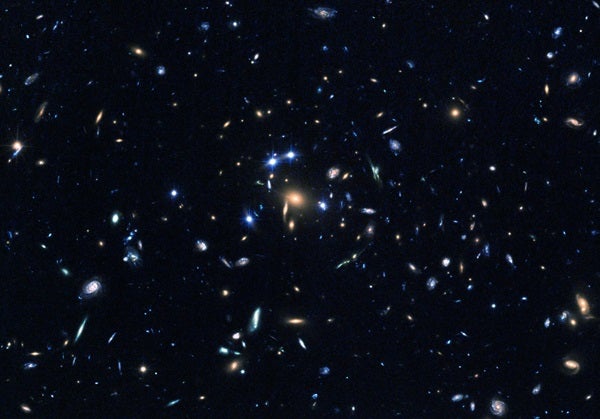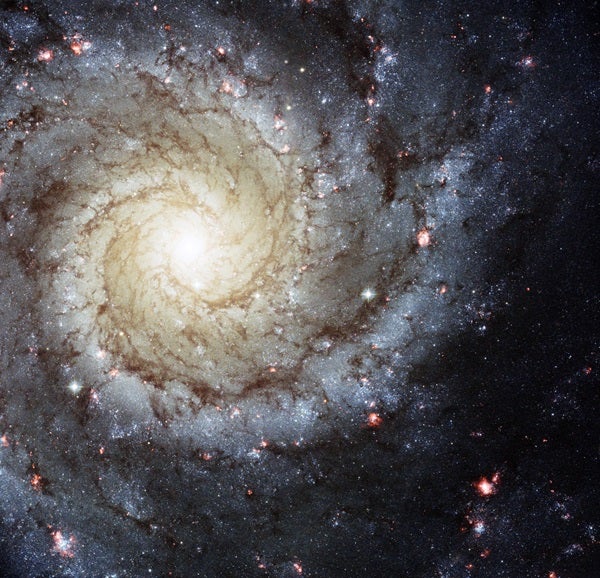It’s absolutely amazing to know that shortly after the Big Bang, the universe was a relatively small, nearly infinitely dense place. It boggles the mind.
But that was 13.8 billion years ago. The expanding universe means the entirety of what we know is now incredibly large — and is getting more immense every day.
This is one area that two generations of science-fiction movies have seriously distorted in the minds of the public. The general feeling that technology is pretty good and will know almost no bounds, and that we can almost certainly one day travel between star systems, is pretty much taken on faith.
But what the sci-fi movies have failed to communicate, among other things, is that the universe is an immensely large place. Even distances between the nearest objects are staggering, and the distances across the Milky Way Galaxy and certainly between galaxies in the universe are astonishingly huge to living beings stuck on a planet. A model of the Milky Way wherein the Sun is a grain of sand brings this home. On this scale, stars — sand grains — are 4 miles (6 kilometers) apart in the Milky Way’s disk and the disk is about 40,000 miles (60,000km) across. Now who wants to go traveling from grain to grain?
The concept of the size of the universe has taken a huge stride forward in just the last few years. There was a time not too long ago when astronomers did not know even the approximate size of the cosmos with any degree of accuracy. We still don’t know with high precision.
Incredible expansion
The Big Bang theory tells us that once the universe was very small. We know the fastest that radiation or any information can travel is the speed of light, 186,000 miles per second (300,000 km/s). We’re confident that the universe is 13.8 billion years old. We also know that a light-year is equal to approximately 6 trillion miles (9.4 trillion km). In nearly 14 billion years, on first blush, we might expect radiation to expand radially outward to something like 30 billion light-years across.
But remember that the Big Bang was not like an explosion that went off in a room. Following the Big Bang, space-time itself expanded radially outward at all points, meaning all of space expanded too, not just the stuff within it. (The term space-time refers to the mathematical model that combines space and time into a single, interwoven medium.)
As the expansion of the universe began, just 1 centimeter of “empty space” interstitially became 2 centimeters over time, and so on. So the best ideas about the size of the universe allowing for its expansion over time point to a radius of slightly more than 46 billion light-years and therefore a diameter for the universe of approximately 93 billion light-years.
But there’s a major proviso to this result. That diameter refers to the visible universe we can see from Earth. Inflation theory, if correct — and it has widespread support among cosmologists — suggests the portion of the universe we can see is by no means the entire cosmos. Some cosmologists propose that the universe is infinite. But let’s work with what we really have and say the cosmos, at least the part that we can observe, is about 93 billion light-years across.
A thorough understanding of our neighborhood, our solar system, our area of the Milky Way, our galaxy, and so on is critical to comprehending how the universe works. And exploring the cosmic distance scale also unveils a slew of interesting objects astronomers use to determine distances to objects near and far.
Little progress took place after Aristarchus until Polish astronomer Nicolas Copernicus (1473–1543) proposed the heliocentric model of the cosmos, and it was one of the last great visual astronomers, Danish nobleman Tycho Brahe (1546–1601), who made the first parallax measurements of comets and helped define a more modern distance scale to nearby objects.
Starting close to home
Let’s pause for a moment to appreciate the physical scale of just our solar system — only the Sun, its attendant planets and debris, and our little island of life inside it. To envision our immediate vicinity a little better in your mind, imagine a scale solar system with the Sun on one end and 1 centimeter representing the distance between our star and Earth, called an astronomical unit (AU). That is, 1 AU = 1 centimeter. You actually can draw this out on paper to help crystallize it in your mind. Tape several sheets of paper together and have at it. With the Sun at one end, Earth is 1 centimeter away, and Mercury and Venus are in there too at 0.4 centimeter and 0.7 centimeter, respectively. Outward from Earth, we have Mars at 1.5 centimeters, the main-belt asteroids centered around 2.5 centimeters, Jupiter at 5 centimeters, Saturn at 9.5 centimeters, Uranus at 19 centimeters, and Neptune at 30 centimeters. Pluto can be placed at 40 centimeters.
The outer solar system is sparse, consisting of the Kuiper Belt region from 30 to 50 centimeters from the Sun, and you can even indicate some of the more interesting objects in the area to keep Pluto company — Haumea at 40 centimeters, Makemake at 45 centimeters, and Eris at 60 centimeters. Now you can finish by indicating the region of the scattered disk, a sparse body of energetically “spun up” icy asteroids, between 50 and 100 centimeters from the Sun. This gives you a complete scale model of the solar system in a region spanning 1 meter, or 3 feet, across.
Now appreciate that on this scale, the inner edge of the Oort Cloud, the vast halo of 2 trillion comets on the solar system’s perimeter, is 100 meters (109 yards, more than an American football field) farther away than the edge of your diagram. The outer edge of the Oort Cloud, on this scale, is 1,000 meters (0.6 mile, more than 10 football fields) away.
Yet as human astronaut-explorers, we only have traveled as far away as the Moon, about 1/389 AU, or on our scale 1/389 centimeter, from Earth, which on this scale is about the size of a human red blood cell. That distance is imperceptibly close to our planet’s “dot” on our scale drawing.
And yet the distances to the nearest stars are larger than our imagined scale of the Oort Cloud. And then come perhaps 400 billion stars scattered across the bright disk of our Milky Way Galaxy, 150,000 light-years across, and a hundred billion more galaxies spread across a vast cosmos.
The next time you’re out under the stars, look up and think carefully about the enormity of the universe. It is one of the great humbling feelings of humanity.











